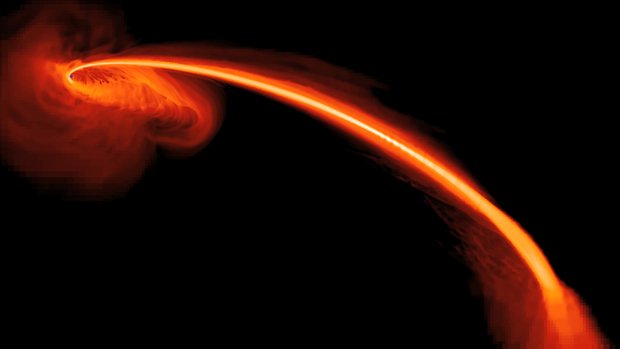Black hole caught swallowing red giant star

ASTRONOMERS HAVE WITNESSED a rare galactic homicide: a supermassive black hole devouring an orbiting star that ventured just a little too close. Such events only occur once every 10,000 years and scientists from the USA were fortunate enough to catch the star’s demise in action.
Lurking in the centre of a galaxy some 2.7 billion light-years from Earth, this supermassive black hole has finally broken its fast by shredding and devouring a red giant star.
A team of astronomers led by Dr Suvi Gerzari of John Hopkins University in Baltimore, US, monitored hundreds of thousands of galaxies using orbiting space telescopes, which scan the entire night sky for all kinds of transient phenomena, including supernovae.
Black holes not perpetual killing machines
The team was looking for a bright flare in ultraviolet light from the nucleus of a galaxy, which is a lingering clue that a black hole has consumed a star. Instead, they discovered an active black hole in the process of consuming a star. The brightness of the glow indicates that the black hole contains three million times as much mass as our own Sun, making it about the same size as the black hole at the centre of the Milky Way.
If a star passes too close to a black hole, it is ripped apart by gravitational forces. Its constituent gases then swirl in toward the black hole generating heat and light before being sucked into the abyss. It is this glow that astronomers search for in their quest to catch an active black hole in the act of consuming a star.
The scientists say they have been waiting for years to see such a phenomenon. Supermassive black holes snack infrequently, making the recent discovery of a black hole in the act of feeding all the more exciting to astronomers.
“Black holes, like sharks, suffer from a popular misconception that they are perpetual killing machines,” comments Dr Ryan Chornock at the Harvard-Smithsonian Centre for Astrophysics (CfA) in Massachusetts. “Actually, they’re quiet for most of their lives. Occasionally a star wanders too close and that’s when a feeding frenzy begins.”
By observing the feast in real-time scientists were able to detect a lack of hydrogen in the atmosphere of the star just before it was swallowed; from this, they deduced the star most likely lost its outer shell on a previous pass by the black hole. “This star barely survived one encounter with the black hole, only to meets its unfortunate end in round two,” says Ryan.
Black hole commits stellar homicide
Astronomers have previously spotted these stellar homicides; “[however], it is the first time we actually had enough detailed information that we can determine what kind of star was torn apart by a black hole and how big the black hole was that did it,” Suvi says.
This is the first such space feast observed from beginning to end, she adds, and “that is very exciting because that time scale is how we determine how big the black hole is”.
The black hole is a region of space where matter is so densely squeezed into a small space that it makes gravity pull strongly enough to stop light from escaping. A supermassive black hole is a black hole that has a mass billions of times the size of our Sun – these are found at the centre of galaxies.
RELATED STORIES

